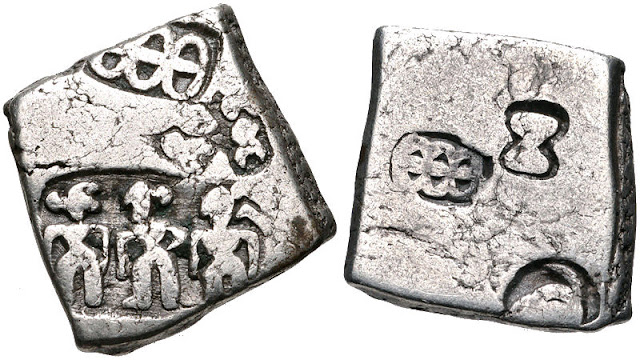 |
| Mauryan Coins |
There were coins dating from 700-500 BC earthed from various parts of India. These coins are made by punching marks on them and known as the Punched Marked coins. Initially, there are one or two marks on them, but these marks increased over the course of time. These marks are also different from the region to the region. Magadha used five different signs where as Panchala used Swastika. These coins are of standard weight but the irregular size and made of silver. The coins are mentioned in Manu Smriti, Panini's Ashthadhyayi, and Buddhist Jataka tales. They are known by the names of Puranas, Krashapana, or simply Pana. Interestingly, the English word "Cash" is taken from the Sanskrit word "Krasha". Saurashtra janapada was probably first to release die-struck coins. These coins were of 1 gram in weight.
In the Arthashastra, Chanakya, the political advisor of the Chandragupta Maurya, was the first notable Indian to advocate for bimetallism for coinage, which involved the use of two metals, copper and silver, under one government. He mentioned four different kinds of coins in his work, suvarnarupa (gold coins), rupyarupa (silver coins), tamrarupa (cooper coins), and sisarupa (lead coins). The use of the punched mark rapidly fell after the disintegration of the Mauryan Empire. The punched mark coins were lost by the die-struck coins. The coins were made by die-struck while still hot, first on just one side, and then on the two sides at a later period.
The first notable gold coins in India were issued by the Indo-Greeks. The first gold coins in large number were issued by the Kushans. There were known as "dinara". Later, the Gupta rulers also issued the gold coins on the large scale.
By the 12th century, the Turkish Sultans of Delhi replaced the Indian designs with Islamic calligraphy. They called them takka or tanka. Iltumish has introduced the Silver Tanka where the Balban introduced the Gold Tanka. Iltumish also introduced copper money known as the copper jittal.
Later, Shershah Suri introduced a silver coin, rupya, weighing 178 grains, and which can be divided into forty copper pieces, paisa. The silver coins remained in use during the Mughal period, the Maratha era, and as well as in the British India era. In 1717, the British obtained permission from the Mughal Emperor Farrukhsiyar to coin Mughal money at Bombay. The British gold coins were named Carolina, the silver coins Angelina, the copper coins Cupperoon and tin coins Tinny. In 1835, the British decimalize the 1 rupee into sixteen annas. Each anna was again divided into 4 paise and each paisa was again divided into three pies. After Independence, a rupee was divided into 100 naye paisa in 1957. After a few years, naye was dropped from the naye paisa.
The coins are an unrivalled source of history about politics, economics, religion and culture. Their 2500 years odd presence can tell us about the things which have not survived the fate of the time.
Tags:
Indian History
